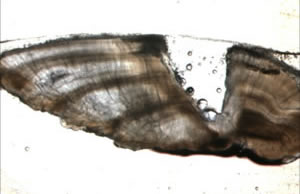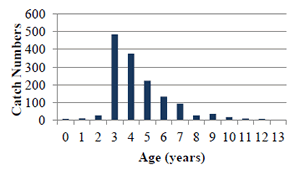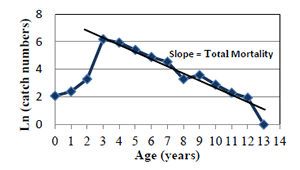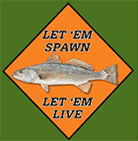Tracking Cobia Population Health
Every year, cobia make a seasonal migration into estuaries and nearshore waters of South Carolina where they become an easy target for recreational anglers. Their accessibility has led to concerns of overfishing among the angling community of Beaufort County. Cobia were once thought to be almost completely pelagic and more or less solitary fish, only occasionally caught by anglers, and very difficult to study. However, South Carolina’s inshore aggregations provide a unique opportunity to collect large amounts of data in a cost-effective manner. Cobia research at SCDNR began in 2007 by collecting life history information from cobia tournaments and through carcass donations. In order to determine if a fish population is healthy or in decline, information on the age structure of the population is required. Prior to 2007, there was very limited information on the age structure and mortality rate of cobia captured in the Atlantic Ocean. To date, SCDNR has processed and aged almost 1,300 cobia, creating one of the largest datasets in the Southeast. This dataset was vital to the recent benchmark cobia stock assessment conducted by the South Atlantic Fisheries Management Council, which began in the spring.

The determination of age is based on a count of annual rings on otoliths, the calcareous structures in the inner ear of a fish. The rings are formed from the changes in growth rates during seasonal variations in water temperature and food availability that produce alternating translucent and dark bands (Fig. 1). These concentric rings called annuli are read in a manner similar to bands of rings on a tree.
In 2007 we determined the age of 352 fish. After aging the fish, we found that cobia collected in South Carolina reach the legal harvestable size limit of 33 inches fork length in two to three years. Yearly reproductive success can vary from year to year with some years producing higher numbers of offspring than others. When we aged all of the cobia from the 2007 samples we found that most of the fish were from the 2004 year-class. This strong recruitment year continues to make up a significant proportion of the catch. That one really good year-class, which reached legal size in 2007, accounts for half of the samples we have aged between 2007 and 2011. The cobia fishery may rely on these occasional very strong year-classes to remain healthy under increasing fishing pressure.

Age data collected over numerous years is also used to determine the age structure and catch frequency of the population and develop catch-curves, which are used to estimate the mortality rate of the population (fig. 2).
In other words, catch curve analyses are based on the idea that a healthy population is made up of old fish as well as young fish. If cobia live to be 13 years old, we would expect that in a healthy population that there would be more three year old fish (when they reach the legal size 33 inches fork length) than four year olds, and less five year olds, and so on. This gives you a gentle slope, which means some fish are dying from natural causes and some fish are harvested from the fishery, but all the year-classes are represented. If the population was overfished, we would probably see very few older fish in the catch because they were being harvested from the fishery too quickly, resulting in a steep slope. Scientists use the slopes to estimate a numerical total mortality rate (fig. 3).

This mortality rate is the sum of natural mortality (M) plus fishing mortality (F). Natural mortality is the loss of fish from a population due to causes other than fishing. Such causes include disease, competition, cannibalism, old age, and predation. Natural mortality varies at different life stages, with larval fish typically experiencing the highest rates and adults experiencing the lowest rates. Natural mortality is one of the most difficult parameters to estimate, but there are a number of methods that take into account life history characteristics such as maximum age, growth, and maturity. For example, fish that mature early and grow quickly are short lived and typically have higher natural mortality rates compared to slow growing, long-lived species. So if you can estimate the total mortality from the slope and subtract out the natural mortality you come up with a number that represents the fishing mortality on the population.
Fishing mortality (F) is all deaths within a population due to fishing activities. This includes fish that are harvested as well as fish that are caught and released but die from causes related to being caught, known as discard mortality. There isn’t much data available on cobia discard mortality, but our experiences with cobia aquaculture lead us to believe that cobia are a pretty tough fish. Discard mortality can be caused by gut-hooking a fish, which causes it to bleed to death. Cobia naturally eat lots of spiny tough animals on the bottom, even stingrays. One cobia that we dissected had 5 stingray barbs embedded in its stomach wall and throat that had healed over, so they tend to be resilient even to hooking.
Determining the age structure and mortality rates of cobia is important to properly managing a healthy population. While natural mortality in cobia is relatively low, fishing mortality has likely increased in the past decade due to the growing numbers of anglers targeting cobia. This concern triggered SCDNR to evaluate cobia captured within South Carolina to determine if overfishing is taking place. Periodic strong year-classes have the potential to offset increases in fishing pressure, but we need to continue to monitor the catch to ensure that the population is at a sustainable level. These mortality estimates are important inputs in the ongoing stock assessment of cobia being conducted by the South Atlantic Fisheries Management Council. The results from this assessment will provide scientists and fisheries managers the information necessary to make good decisions that ensure cobia are available for future generations.



